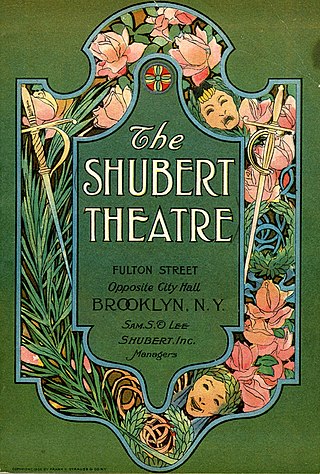
The Shubert Organization is a theatrical producing organization and a major owner of theatres based in Manhattan, New York City. It was founded by the three Shubert brothers — Lee, Sam, and Jacob J. Shubert — in the late 19th century. They steadily expanded, owning many theaters in New York and across the United States. Since then it has gone through changes of ownership, but it is still a major theater chain.
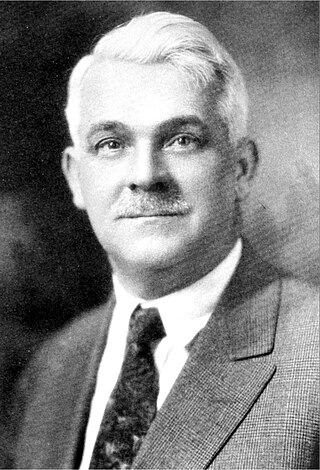
Thomas White Lamb was a Scottish-born, American architect. He was one of the foremost designers of theaters and cinemas of the 20th century.

Edward Franklin Albee II was an American vaudeville impresario.
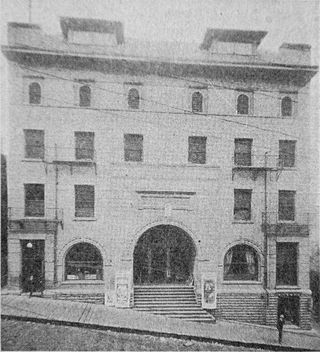
The Grand Opera House in Seattle, Washington, US, designed by Seattle architect Edwin W. Houghton, a leading designer of Pacific Northwest theaters, was once the city's leading theater. Today, only its exterior survives as the shell of a parking garage. Considered by the city's Department of Neighborhoods to be an example of Richardsonian Romanesque, the building stands just outside the northern boundary of the Pioneer Square neighborhood.
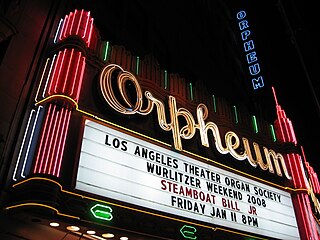
The Orpheum Theatre at 842 S. Broadway in Downtown Los Angeles opened on February 15, 1926, as the fourth and final Los Angeles venue for the Orpheum vaudeville circuit. After a $3 million renovation, started in 1989, it is the most restored of the historical movie palaces in the city. Three previous theatres also bore the name Orpheum before the one at 842 Broadway was the final one with that moniker.

The Grand Opera House was an opera house and concert hall located in Toronto, Ontario, Canada.

Pike's Opera House, later renamed the Grand Opera House, was a theater in New York City on the northwest corner of 8th Avenue and 23rd Street, in the Chelsea neighborhood of Manhattan. It was constructed in 1868, at a cost of a million dollars, for distiller and entrepreneur Samuel N. Pike (1822–1872) of Cincinnati. The building survived in altered form until 1960 as an RKO movie theater, after which it was replaced by part of Penn South, an urban renewal housing development.

The Palace Theatre is a 2,695-seat restored movie palace located at 34 W. Broad Street in Columbus, Ohio. It was designed and built in 1926 by the American architect Thomas W. Lamb as part of the American Insurance Union Citadel. Today the theater functions as a multi-use performing arts venue. It is owned and operated by The Columbus Association for the Performing Arts. The Palace Theater's "house" is considered separate from LeVeque Tower, while the marquee and lobby are part of the LeVeque complex.

Lottie Gilson was a popular Swiss-born American comedian and vaudeville singer of the 1880s and 1890s. She was billed as "The Little Magnet" in recognition of her ability to attract and engage audiences. Due to her popularity, she was much sought-after by Tin Pan Alley publishers to boost sheet music sales. Songs particularly associated with Gilson include "The Sunshine of Paradise Alley", "The Little Lost Child", "The Sidewalks of New York", and "My Mother Was a Lady". Her come back song "Just a Plain Little Irish Girl," is the only known surviving recording.

The Orpheum Circuit was a chain of vaudeville and movie theaters. It was founded in 1886, and operated through 1927 when it was merged into the Keith-Albee-Orpheum corporation, ultimately becoming part of the Radio-Keith-Orpheum (RKO) corporation.
Subway Circuit is a term that was created before 1914 to define a group of legitimate New York City theaters featuring shows passing out from Broadway and usually prefacing their "going on tour" or used to get a try-out of a show before being sent to Broadway for a verdict. The theater also had to be reachable by New York City Subway.

The Strand Theatre, sometimes known as the 1918 Strand Theatre, at 647 Fulton Street and Rockwell Place, adjacent to Brooklyn Academy of Music's Harvey Theatre, was a vaudeville house that is currently home to BRIC and UrbanGlass following a two-year renovation from 2011 to 2013.

William H. McElfatrick was an American architect who specialized in theaters.
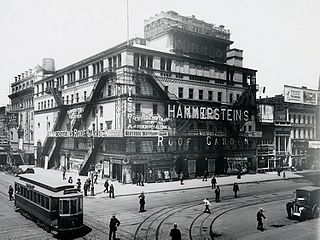
The Victoria Theatre was a prominent American vaudeville house during the early years of the twentieth century. Theatre mogul Oscar Hammerstein I opened it in 1899 on the northwest corner of Seventh Avenue and 42nd Street, along New York City's Longacre Square. The theatre was closely associated with the Paradise Roof Garden above it, and the two venues came to be known collectively as Hammerstein's. The Victoria closed in 1915.
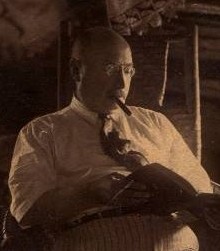
Percy Garnett Williams was an American actor who became a travelling medicine salesman, real estate investor, amusement park operator and vaudeville theater owner and manager. He ran the Greater New York Circuit of first-class venues. Williams was known for giving generous pay and good working conditions to performers. At his death, he endowed his Long Island house as a retirement home for aged and destitute actors.
William Hammerstein was an American theater manager. He ran the Victoria Theatre on what became Times Square, Manhattan, presenting very popular vaudeville shows with a wide variety of acts. He was known for "freak acts", where celebrities or people notorious for scandals appeared on stage. Hammerstein's Victoria Theatre became the most successful in New York.

Olympic Theatre was the name of five former 19th and early 20th-century theatres on Broadway in Manhattan and in Brooklyn, New York.
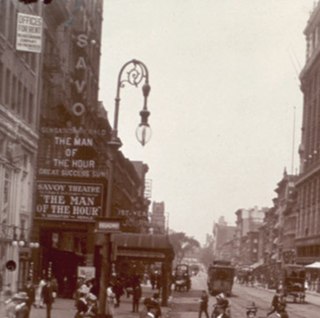
The Savoy Theatre was a Broadway theatre at 112 West 34th Street in Midtown Manhattan, New York City. It opened in 1900. It was converted to a cinema around 1910, until it was closed in early 1952 and then demolished.
The Grand Opera House was a theatre in Brooklyn, New York that was in operation from 1881 through 1920. The theatre was demolished in 1924 along with several adjacent buildings to make room for the A. I. Namm & Son Department Store.

Caroline Madeline Gardner, better known by her stage name Carrie Swain, was an American actress, acrobat, and singer. One of the first female acrobats and belting vocalists to appear in vaudeville, she began her career performing in variety and minstrel shows during the 1870s. She first rose to national prominence in the early 1880s, touring in the musical The Tourists of the Palace Car. In 1882 she created the role of Topsy in composer Caryl Florio and dramatist H. Wayne Ellis's musical adaptation of Uncle Tom's Cabin, and then toured nationally in several plays written for her, among them Leonard Grover's Cad, the Tomboy and Frederick G. Maeder's Mat, the Romp.
















